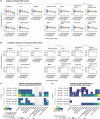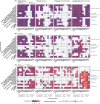Disease stage-specific atrophy markers in Alzheimer's disease
- PMID: 40691867
- PMCID: PMC12279471
- DOI: 10.1002/alz.70482
Disease stage-specific atrophy markers in Alzheimer's disease
Abstract
Introduction: Structural magnetic resonance imaging (MRI) often lacks diagnostic, prognostic, and monitoring value in Alzheimer's disease (AD), particularly in early disease stages. To improve its utility, we aimed to identify optimal atrophy markers for different intended uses.
Methods: We included 363 older adults; cognitively unimpaired individuals who were negative or positive for amyloid beta (Aβ) and Aβ-positive patients with subjective cognitive decline, mild cognitive impairment, or dementia of the Alzheimer type. MRI and neuropsychological assessments were administered annually for up to 3 years.
Results: Accelerated atrophy of medial temporal lobe subregions was evident already during preclinical AD. Symptomatic disease stages most notably differed in their hippocampal and parietal atrophy signatures. Atrophy-cognition relationships varied by intended use and disease stage.
Discussion: With the appropriate marker, MRI can detect abnormal atrophy already during preclinical AD. To optimize performance, atrophy markers should be tailored to the targeted disease stage and intended use.
Highlights: Subregional atrophy markers detect ongoing atrophy in preclinical Alzheimer's disease (AD). Subjective cognitive decline in preclinical AD links to manifest atrophy. Optimal atrophy markers differ by the disease stage and intended use.
Keywords: imaging biomarker; longitudinal atrophy; magnetic resonance imaging; medial temporal lobe; parietal lobe.
© 2025 The Author(s). Alzheimer's & Dementia published by Wiley Periodicals LLC on behalf of Alzheimer's Association.
Conflict of interest statement
J.W. has been an honorary speaker for Beeijing Yibai Science and Technology Ltd, Eisai, Gloryren, Janssen, Pfizer, Med Update GmbH, Roche, Lilly, Roche Pharma; has been a member of the advisory boards of Abbott, Biogen, Boehringer Ingelheim, Lilly, Immungenetics, MSD Sharp‐Dohme, Noselab, Roboscreen, and Roche Pharma; and receives fees as a consultant for Immungenetics, Noselab, and Roboscreen. J.W. holds the following patents: PCT/EP 2011 001724 and PCT/EP 2015 052945. All other authors report no conflicts of interest relevant to this work. Author disclosures are available in the supporting information.
Figures



Update of
-
Disease stage-specific atrophy markers in Alzheimer's disease.medRxiv [Preprint]. 2025 Mar 14:2025.03.13.25323904. doi: 10.1101/2025.03.13.25323904. medRxiv. 2025. Update in: Alzheimers Dement. 2025 Jul;21(7):e70482. doi: 10.1002/alz.70482. PMID: 40162264 Free PMC article. Updated. Preprint.
References
-
- Ossenkoppele R, Smith R, Mattsson‐Carlgren N, et al. Accuracy of tau positron emission tomography as a prognostic marker in preclinical and prodromal Alzheimer disease: a head‐to‐head comparison against amyloid positron emission tomography and magnetic resonance imaging. JAMA Neurol. 2021;78(8):961‐971. doi: 10.1001/jamaneurol.2021.1858 - DOI - PMC - PubMed
MeSH terms
Substances
Grants and funding
LinkOut - more resources
Full Text Sources
Medical

